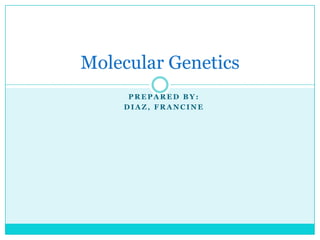
Molecular genetics ppt
- 1. Molecular Genetics PREPARED BY: DIAZ, FRANCINE
- 2. DNA Structure Watson and Crick determined that DNA is a polymer of nucleotides arranged in adouble helix. Each nucleotide is composed of a phosphate group, a sugar (deoxyribose), and a base. There are a total of four bases: adenine, thymine,cytosine, and guanine. Adenine and guanine are purines while cytosine and thymine are pyrimidines. Base-pairing occurs between adenine and thymine and between guanine and cytosine.
- 3. Additionally, a strand of DNA has a 5' end and a 3' end (determined by the attachment of the phosphate to deoxyribose). In the double helix, each strand of DNA runs antiparallel (in the opposite direction) to the other so that the 5' end on one strand is across from the 3' end of the other.
- 4. RNA Structure RNA is a polymer of nucleotides. Unlike DNA, however, RNA is single- stranded. Also, the base thymine is replaced by the base uracil and the sugar ribose is used instead of deoxyribose.
- 5. There are three kinds of RNA. Messenger RNA (mRNA) carries a copy of the DNA code to theribosomes during protein sythesis. Transfer RNA (tRNA) transports amino acids (used to form proteins) to their proper place on the mRNA template. Ribosomal RNA (rRNA) are the building blocks of ribosomes. They are created in the nucleolus.
- 6. DNA Replication Promoter proteins are produced and bind to DNA at several sites. Helicases attach to promoter proteins and break the hydrogen bondslinking the bases together to open the helix up. RNA polymerase reads the exposed nucleotides and produces an RNA primer (approximately 10 nucleotides in length). DNA polymerase replicates the DNA (base-pairing) forming the new strand in the 5' to 3' direction.
- 7. Because DNA polymerase only reads in the 3' to 5' direction, and forms the new strand in the opposite direction, there is a directional problem. Therefore one molecule of DNA produces a continuous leading strand in one direction. On the lagging strand, new primers have to form at many sites and the DNA is broken up into many small fragments called Okazaki fragments. The process of DNA replication occurs at many sites, called replication bubbles, along the entire DNA strand.
- 8. When DNA polymerase reaches the 5' end of the RNA primer, it is released and other enzymes remove the RNA primers and replace them with the proper nucleotides. DNA ligase joins together all of the large leading fragments and the many small Okazaki fragments. DNA polymerase also checks and corrects any mistakes in base pairing. Topoisomerases prevent kinks as the parent DNA is unzipped.
- 10. Mutation Mistakes in base-pairing are corrected by DNA polymerase and other mismatch repair enzymes. Radiation and various reactive chemicals can cause thymine dimers where adjacent nucleotides bind to each other instead of to the complimentary strand. Such errors are usually fixed by splicing out the affected nucleotides and replacing them (excision repair).
- 11. A mutation is a DNA error that is not repaired. Some mutations include using an incorrect nucleotide (substitution), deleting a nucleotide (deletion), and adding a nucleotide (insertion). When insertion occurs, all the subsequent nucleotides are misplaced causing a frameshift mutation.
- 12. Protein Synthesis Protein synthesis is divided into two phases: transcription and translation. In transcription, RNA polymerase unzips DNA and reads it in the 3' to 5' direction. Free RNA nucleotides are base paired with the exposed DNA nucleotides and assembled into mRNA. The mRNA then leaves the nucleus and moves to the ribosomes in the cytoplasm. Transcription ends and translation begins.
- 13. Translation has four stages. 1. In the amino acid 2. In the initiation activation stage the ribosome stage amino acids are moves along the mRNA attached to the strand until it reaches appropriate tRNA mole the code for formyl cules. A molecule of methione (AUG). ATP is used to activate the tRNA.
- 14. 3. In the elongation 4. In the termination stage the tRNA matches stage a nonsense code is its anti-codon (three reached and the protein is nucleotides) with the released. mRNA codon (three nucleotides). The amino acid on the previous tRNA is transferred to the newly arrived tRNA and the empty tRNA leaves. This is repeated over and over as the ribosome moves along the mRNA strand.